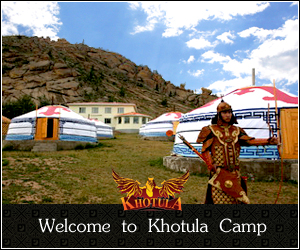Mongol State Structure and Organization
The supreme power rested in the hands of Genghis. However a hierarchy of power existed in positions such as Prime Minister or State Van, State Judge, Ministers and State shaman. The nine courtiers or “champs” who served loyal to the Khan were honored in the state. All champs were freed from any form of taxes. The Council of Wise men” and “Great Khurildai” were under the direct rule of Genghis Khan. When urgent issues and problems arose, Genghis turned to “The Council of Wise men” for their advice. Khans, princes, brothers, big noblemen and high officials of that time took part in the “Great Khurildai” in order to discuss urgent and important matters such as electing a new Khaan, waging war and making peace.
The new development in the structure of the State system was the title and position of State Judge. All legal disputes and procedures were under his direct control and monitoring. The very first State Judge of Mongolia was the great statesman, Shikhikhutug. Chinggis appointed him to control all judicial affairs and ordered him to take a record of every legal proceeding. Also Genghis Khan ordered that no one could change his decision or interfere with his affairs.
The main law of the State was the “Great Yasa”. The original text of the Great Yasa has been lost, but some its provisions were left in the manuscripts and historical records. The main idea of the Great Yasa was to protect the nobles and lords. For example, 13 out of 36 provisions were to execute the guilty man. The Great Yasa regulates affairs such as electing the Khan, establishing and maintaining relationships with other countries, organizing the Ikh Khurildai (grand council), setting obligatory duties for serfs and people, granting title of “Champ”, conducting military affairs, hunting, carrying out financial issues, levying tax, family affairs and inheritance. Serfs’ moving from one tenth district to another or hundredth to another was strictly prohibited and law breakers would face execution. Also there were many provisions for strengthening military organization and discipline in the “Great Yasa”.
Khishigten- The Khan’s guard was called Khishigten (the origin of khishig is gratitude in Mongolian). It was a shift of herders or soldiers. Khishigten was 2 shifts: day and night. The senior khishigten was the main group of warriors in the Mongol army. After establishing the Mongol State, Genghis Khan made a khishigten of up to 10,000 men and organized them precisely. Chiefs of the ten thousandth, thousandth, hundredth, tenth and wealthy herders were selected by their abilities and skills in fighting and education.
Groups of a thousand were accompanied by a squire and a brother, a hundred, five squires and a brother and ten, three squires and a brother together with his horses.
The day guard was divided into 4 groups and the whole unit was called a khishig. The Khishigten wer the main warriors in the battlefield and dealt with various duties along with their direct duties in peace. Genghis Khan renewed the duties and organization of the khishigten. According to this new organization, khishigten were divided into khorchin, khevtuul, baatar and torguud warriors and each of them had separate duties.
a. Khorchin. Khorchin originated from khor (arch and bow). “Therefore, Khorchin means archers” said historian D.Gongor. Also, Khorchins were in charge of the daily guard of the Khan and they were shifted by khevtuuls before the sunset. They had to sleep outside of the court. In the next morning, the Khorchin had to wait in a nearby horse stop until Genghis Khan and his sons finished their breakfast. The Khorchins numbered 1000.
b. The Khevtuul’s duty was to protect and guard the Khan’s court at night. The word Khevtuul means to assure a peaceful and calm night. Therefore, the duties of khevtuul were precise. For example, after sunset, khevtuuls captured people passing by the court at night and questioned them in the morning. At the end of the shift, khevtuuls gave back their badges and walked away. Khevtuuls guarded the court at night to arrest suspicious people and possibly even behead them. The number of khevtuuls was secret and the khevtuul had a right to take the horse, saddle, reigns and all the clothes of a man who asked about their number. Also they managed the affairs of the camels, cattle herders, serfs and women of the court. They were responsible for the flag, banner, saddle shoes and spears. Their duties were accurately described in the “Secret History of Mongolia” as follows: “Khevtuuls are in charge of the kitchen and food supply. Khevtuuls are responsible for our food stuff. During the shortage of food, one who is delivering food should ask permission from the khevtuuls. When delivering food one should inform to the khevtuul in charge. Let the khevtuul be in charge of stuff in and out of the court. Near to the doorway of ger, there will be doormen of khevtuuls and two khevtuuls will enter inside and guard the great treasure” Khevtuuls examined the camping spots when moving the court on cart, which khevtuuls guarded on both sides. When Temujin was Khan of The Mongol Empires , the number of khevtuuls was 80 and later it reached to 1000. The khevtuuls were basically the police or special guard. Genghis Khan established his state like this way. Moreover, khevtuuls were excellently trained in close combat and martial arts. For example, it is clearly seen in one of the decrees that khevtuuls should paralyze one who tries to sneak to the court and behead him.
c. Baatar warriors. These warriors were best of the best, selected from ten thousand khishigten and led by Arkhai Khasar. There were only 1000 of them. The Baatar warriors’ duty was described in the Secret History of Mongolia as follows. “In peace, they will be the Khan’s guards and in war they will lead the army. In addition, these Baatar warriors were the vanguard when moving the Khan’s court cart.
d. Torguud. This word is originated from “Turkhag” in Mongol language and means healthy and fit body or man of great physical strength












